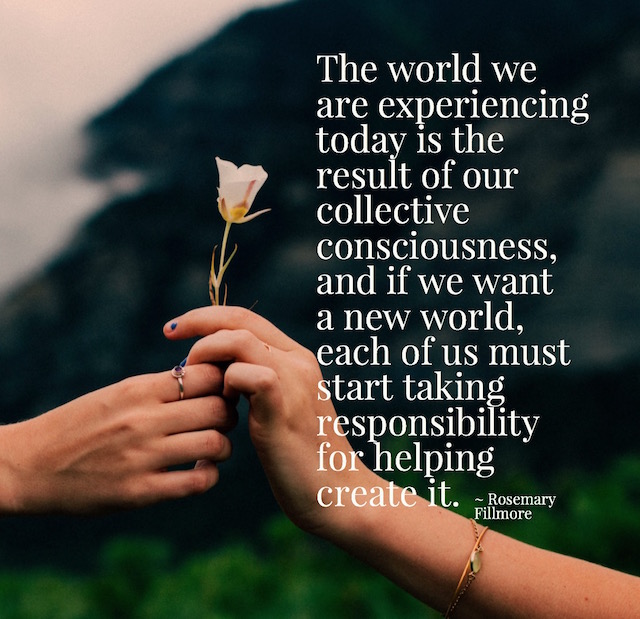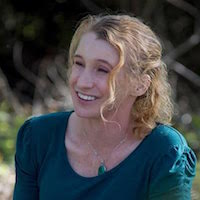A week ago in Sutherland Springs, Texas, a man chose to incite chaos, darkness, and fear.
And a few weeks before that, another man made the same choice in Las Vegas.
Why? It was a direct effect of what they felt. They felt anger. They felt fear.
So, they created chaos. They fed the darkness. In the process, they created more fear, as well as immeasurable pain and suffering. This is clearly the worst of humanity in action, but we all send out what we feel, and we are all responsible for creating our collective reality.
How? We’re all connected by a web of energy known as the collective consciousness. This web contains all of the thoughts and feelings of every human on the planet. Ever thought of someone, and then they called or texted at that moment? That’s the collective consciousness in action.
Because we are all connected, every time we feel anger, we create more collective chaos. Every time we feel fear, we feed the darkness in the world. We create more tragedy.
However, our tragedies have a purpose. They show us our collective wounds that need to be healed, the darkness that is begging to be transformed into light. They also create compassion and serve as a catalyst for understanding and unity. Although we may not agree on everything, we understand each other’s pain. We become unified in our suffering.
Right now, tragedies are the primary way that humanity finds understanding and unity, but it doesn’t have to be this way. We can change this by using our emotions and thoughts to create more love and light. Love is the emotion that brings people together. Light is the energy that heals us. By transforming our anger and fear into love and light, we create understanding—the formula for unity. Because we are all connected through the collective consciousness, as more of us choose to do this, our tragedies will diminish.
Eventually, they will be eliminated altogether.
Let’s look at the science behind the collective consciousness. In an interview with The Huffington Post, John Hagelin, a Quantum physicist, explains:
“Stressed individuals create a stressed society—a stressed collective consciousness. And everyone embedded within that stressed society feels that societal stress. It thereby feeds upon itself…(Conversely), individual practice of certain evidence-based, stress-reducing techniques (such as meditation, which fills us with more light energy) relieves individual stress, according to extensive published research. And the practice of these techniques by a significant sub-portion of a population (even one percent) has been similarly shown to reduce societal stress, leading to substantially reduced violent crime, psychiatric crisis calls, and other indicators of acute societal stress.”
So, even a small percentage of the population deciding to be conscious conductors of light can affect the whole of humanity.
Think this isn’t possible? Let’s look at the science again. The Global Consciousness Project is “an international, multidisciplinary collaboration of scientists and engineers” based out of Princeton University. Their goal is to measure shifts in the collective consciousness on a global scale that are correlated with specific events. They measure shifts in the collective consciousness via “a network of random number generators (RNGs) spread around the world.” There are roughly 70 stations set up around the world, and they function independently.
However, when events happen that trigger a global reaction, the stations begin to produce patterns. The closer the stations are, the more clear the pattern. The greatest similarity in these patterns is seen with events that trigger compassion and empathy. Events that evoke fear do not have as profound an effect on the patterns. This is because compassion and empathy are emotions that bring people together and cause us to connect, while fear and panic isolate people, because they cause us to think about our individual survival.
Basically, this tells us that compassion and empathy are more powerful than fear and panic—and they are true catalysts for unity.
The time for unity has come. In fact, it is the next step in our evolution as a species. This would seem to defy Darwin’s evolutionary theory of the “survival of the fittest” that is so ingrained in our western culture. However, in his work The Descent of Man, Darwin’s research (actually) “shows that ‘survival of the kindest’ is more correct for explaining which species climb the evolutionary ladder efficiently and effectively.” Darwin believed that compassion was not only a natural human instinct, but was necessary for the species to survive and thrive.
Spring-boarding off of Darwin’s actual theory of “survival of the kindest,” Edward O. Wilson, a biologist and theorist, has shown that: “Our evolution from tribal into a global society increasingly favors compassionate and cooperative over callous and competitive approaches to human interaction.”
So, when we choose to become conscious conductors of light, we not only create unity, but we also ensure the survival of humanity as we guide ourselves collectively through the next stage of our evolution.
So how do this? How do we release our anger and embrace understanding? How do we let go of our fear to make room for light to come in?
To begin with, we recognize that anytime we feel anger or fear, we are feeling wounds that need to be healed. We are being shown our darkness that needs to be transformed into light.
The first step in transforming any emotion is to learn to be in the emotion, but not of it—to separate the emotion from the raw energy behind it. Emotions are fueled by energy, and it is the thoughts that we add to the energy that charge it with emotion.
Think of it as a recipe: the energy is the raw ingredient. The thoughts around the energy are what give the dish its flavor, what create the emotion. Anger and fear come from the same dark energy. Anger is fear disguised as righteousness, and it is our greatest hindrance to unity. When we feel angry at someone else, it is because we think they are the cause of our distress. We feel dark energy within us, and we blame “the other.”
But, because we’re all connected, there really is no other. So, any time we feel anger, instead of sending the energy outward, toward others, we can choose to begin by sitting with it. We can find where it is located in our body. Where do we feel it? Is it in our belly? Our chest? Our throat?
At this point, we can just try to just observe the energy with no thoughts and no judgement. This is what it means to be in the energy, but not of it. Then, we can begin the process of lifting it out with light energy. Energy ebbs and flows, so as we feel the anger rise, we can then lift it up with our in breath and visualize flooding that area of our body with light. With each inhale, we feel the energy rise in our body, higher with each breath. With each exhale, we visualize the dark energy exiting our body through our out-breath. We continue until we have brought the dark energy all the way to the crown of our head, and then, with our breath, we push it right on out of our body through the top of our head.
We have transformed dark energy into light. We have become a conscious conductor of light, and in so doing, we have added more light energy to the collective consciousness. We have healed a personal wound—and in so doing, we have healed a wound of the collective.
Throughout this process, it is important to remember not to be afraid of the darkness within us. We have to look at the dark places in ourselves in order to heal them. In this way, darkness is a catalyst for light. When we are children, we are afraid of the dark. But then we turn on the light, and a new perspective is created. When we shine a light on our darkness, we create a new perspective. We see that we have nothing to fear.
Once we’ve transformed our darkness into light, how do we begin to embrace understanding? How do we send more love into the collective? First, we use our thoughts to create it. We think about the the target of our anger. We think about the fear they must feel. The isolation. The knot in their stomach. Their broken heart.
And then, we feel the compassion start to rise within us. It may begin in our heart. In our belly. In our throat. And instead of lifting it up and out, we bring it down and pull it inward, until it washes over us. Until our body is flooded with compassion. Until we don’t see “the other” anymore. Instead, in the other, we see ourselves. We have used our thoughts to create more understanding. We have used our emotions to create more love energy. In the process, we have become more unified.
We live in times of great polarization. It’s easy to become passionate about our beliefs, and passion is indeed a driving force for change. But, when we see the world through the lens of “us versus them,” our passion turns to anger. To bitter gall. We need to recognize this in ourselves. How does it feel? Not very good.
Emotions are energy, and energy is a boomerang. If we feel anger, we’re sending anger out. Then guess what? It comes back to us—on steroids. The greatest wars and the most suffering have commenced in this way.
Let us not send anger. Let us send compassion. Let us send light. We truly are all in this together. The time for division is over. It’s not us versus them. It’s not black versus white. Nothing ever is; everything is gray.
We are all human. We are literally connected by a web of energy, and we can influence each other for good or ill. So let’s go with the good, shall we? Let’s stop looking at what others should do differently and start looking at ourselves. How can we bring more love and light to our collective? How can we create more understanding? If even a small percentage of us decide to do this, we will create unity and free ourselves from the need to experience tragedy.
And in unity, we will create what we actually seek: peace, equality, and the world we want our children to inherit.
Indeed, it’s the next stage of our evolution.
~
~
Author: Jessica Gammell-Bennett
Image: Elephant Journal archives
Editor: Callie Rushton
Copy Editor: Yoli Ramazzina
Social Editor: Waylon Lewis







Read 6 comments and reply